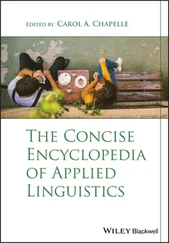Sandrine Zufferey - Introduction to Experimental Linguistics
Здесь есть возможность читать онлайн «Sandrine Zufferey - Introduction to Experimental Linguistics» — ознакомительный отрывок электронной книги совершенно бесплатно, а после прочтения отрывка купить полную версию. В некоторых случаях можно слушать аудио, скачать через торрент в формате fb2 и присутствует краткое содержание. Жанр: unrecognised, на английском языке. Описание произведения, (предисловие) а так же отзывы посетителей доступны на портале библиотеки ЛибКат.
- Название:Introduction to Experimental Linguistics
- Автор:
- Жанр:
- Год:неизвестен
- ISBN:нет данных
- Рейтинг книги:4 / 5. Голосов: 1
-
Избранное:Добавить в избранное
- Отзывы:
-
Ваша оценка:
- 80
- 1
- 2
- 3
- 4
- 5
Introduction to Experimental Linguistics: краткое содержание, описание и аннотация
Предлагаем к чтению аннотацию, описание, краткое содержание или предисловие (зависит от того, что написал сам автор книги «Introduction to Experimental Linguistics»). Если вы не нашли необходимую информацию о книге — напишите в комментариях, мы постараемся отыскать её.
Introduction to Experimental Linguistics — читать онлайн ознакомительный отрывок
Ниже представлен текст книги, разбитый по страницам. Система сохранения места последней прочитанной страницы, позволяет с удобством читать онлайн бесплатно книгу «Introduction to Experimental Linguistics», без необходимости каждый раз заново искать на чём Вы остановились. Поставьте закладку, и сможете в любой момент перейти на страницу, на которой закончили чтение.
Интервал:
Закладка:
4 4) A researcher wishes to examine the influence of alcohol consumption on fluency while speaking a foreign language. Imagine how to observe the variable alcohol consumption and then how to manipulate it. What should you consider if you decide to manipulate this variable?
5 5) Why is it important to manipulate variables in experimental research?
6 6) What different types of external variables are there in research? What strategies are used for controlling them?
1.7.2. Answer key
1) The inductive approach consists of observing a phenomenon in its context in order to build comprehension. This approach is essentially flexible and gradually adapts to the emergence of new elements as they appear while studying a certain phenomenon. By contrast, the deductive approach formulates hypotheses on the basis of a theory and verifies them by using data acquired in a controlled manner. When constructing a research question, it may be interesting to start with an inductive approach in order to understand the phenomenon that one wishes to study. The elements resulting from this approach can then be translated into the form of empirically testable hypotheses. For example, when interviewing bilingual people, it could appear that these people often report feeling like they do not have the same reactions or the same personality when they speak their mother tongue or their second language. On this basis, a hypothesis could be formulated as to the relationship between the language spoken and the personality of bilingual people. This hypothesis could then be tested by collecting objective data on the personality of the speakers in their mother tongue and in a different language.
2) One possibility for implementing a qualitative study would be to conduct in-depth interviews on the theme of the tip-of-the-tongue (TOT) phenomenon with a limited number of people. During these interviews, we could first let people express their feelings spontaneously, and then later ask them one or more questions specifically intended to collect their opinion on the influence of fatigue on this phenomenon. From these interviews, we could discover that people feel like they tend to have more TOTs when they are tired. Attempts to explain this cause could also be suggested.
One possibility for carrying out a quantitative study would be to give a task to a large number of people aimed at provoking TOTs, and then to compare the number of TOTs encountered by tired and by less tired people. For example, an adequate task would be to give word definitions to the participants and then ask them to name the word corresponding to each definition. The tiredness variable could simply be observed in the study, by asking the participants to assess their level of tiredness in order to classify them into two groups. Tiredness could also be manipulated by researchers, by creating conditions of tiredness to place participants in. One could decide to manipulate tiredness by asking one group to carry out a tiring task before the naming task, while the other group could rest for a moment before the task.
3) Remember that a testable research hypothesis must identify a cause and a consequence, as well as a directional relationship between them. Furthermore, it must be operationalized, that is, the measures of the various variables should be determined. Proposals (b) and (d) meet these criteria, which is not the case for proposals (a) and (c).
a) is a general assumption, which does not identify the key factor in question. This proposal could lead to a large number of different research questions. In order to turn it into a testable hypothesis, a factor for focus should be determined, as well as what is meant by learning a language. One possibility among many would be to hypothesize that the age when one begins learning a language determines the proficiency attained in such language a year later. The means of determining language proficiency should be further clarified; for example, it could correspond to the results of a standardized language test.
c) should clarify what is meant by ease. Ease of learning a language could be objectively measured by using a language test after a certain period of learning. This easiness could also correspond to another aspect of learning, such as the learners’ perception about their learning processes. In this case, it could be measured using a scale on which learners would rate the perception of their ability to learn Italian, for example, from 0 (very difficult) to 10 (very easy).
4) To simply observe alcohol consumption, the researcher could go to a bar in the evening, ask those present for the number of glasses of alcohol consumed and then measure their fluency in speaking a foreign language. In this case, the danger would be that the different groups (less than two glasses vs. more than five glasses, for example) would not be equal with respect to other variables that could influence the dependent variable, such as mastery of the foreign language, or the habit of expressing themselves in that language. External variables could be controlled by manipulating the variable, for example, by choosing two equal groups of participants who would be asked to drink water or alcohol, before testing their fluency in speaking a foreign language. In the second case, ethical questions would arise as to the cost/benefit ratio of such research. It would also be advisable to help participants having consumed alcohol, leave the experiment in a similar state to when they arrived.
5) Manipulating variables makes it possible to establish a cause and effect relationship between independent variables and dependent variables. By controlling the external variables, so as to isolate the independent variable and by establishing precise conditions, it is possible to draw conclusions about the influence of one variable on another.
6) External variables are uncontrolled variables which can influence the variables examined in a study. These variables can be related to the participants and/or to the items of the experiment. In order to control them, it is necessary to recruit many people and to use many items in an experiment. Moreover, people should be randomly assigned to the different conditions and should be naive, that is, they should ignore the goals of the experiment. Confounding variables, a class of external variables, are related to both independent and dependent variables. The existence of confounding variables casts doubts on research findings, which is why it is necessary to identify and control them, for example, by keeping them constant between conditions. In Chapters 2and 6, we will see that there are different ways of controlling external variables.
1.8. Further reading
Litosseliti (2018) provides an overview of the difference between qualitative and quantitative research in linguistics, as well as the means of combining them. For a more detailed introduction to quantitative research and experimental research, we recommend Gass (2015) and Phakiti (2015), devoted to applied linguistics but whose principles are properly suited for all areas of linguistics. To deepen the comprehension of the different types of quantitative research and scientific logic, we recommend Chapter 1by Field and Hole (2003). Even if this work is primarily intended for psychologists, the examples are clear enough for all people to understand. Finally, for a point of view committed to experimental linguistics in the fields of syntax and semantics, we recommend the articles by Gibson and Fedorenko (2010, 2013), as well as the response by Culicover and Jackendoff (2010) for the opposite opinion. For the principles of corpus linguistics, see Zufferey (2020).
Конец ознакомительного фрагмента.
Текст предоставлен ООО «ЛитРес».
Читать дальшеИнтервал:
Закладка:
Похожие книги на «Introduction to Experimental Linguistics»
Представляем Вашему вниманию похожие книги на «Introduction to Experimental Linguistics» списком для выбора. Мы отобрали схожую по названию и смыслу литературу в надежде предоставить читателям больше вариантов отыскать новые, интересные, ещё непрочитанные произведения.
Обсуждение, отзывы о книге «Introduction to Experimental Linguistics» и просто собственные мнения читателей. Оставьте ваши комментарии, напишите, что Вы думаете о произведении, его смысле или главных героях. Укажите что конкретно понравилось, а что нет, и почему Вы так считаете.



![Andrew Radford - Linguistics An Introduction [Second Edition]](/books/397851/andrew-radford-linguistics-an-introduction-second-thumb.webp)








